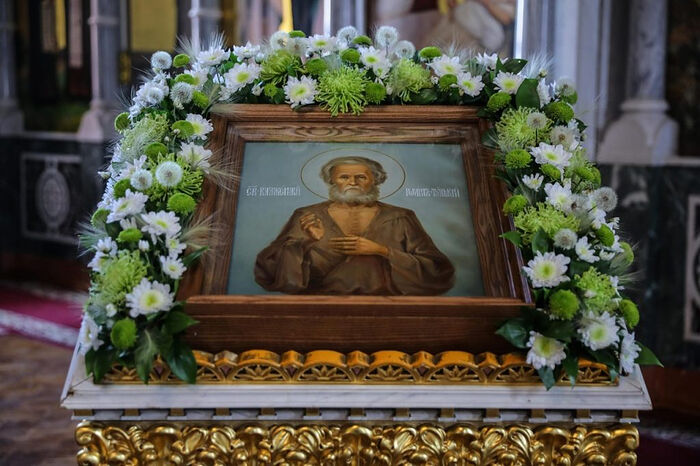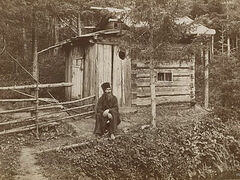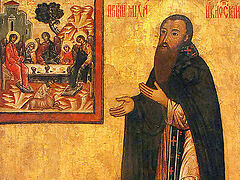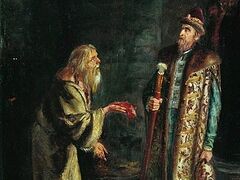The Tula Province, like other regions, is rich in holy righteous men who pleased God with their lives and acquired His grace and mercy. One such righteous man was Blessed John the Wonderworker, the patron saint of the Tula lands, whose holy incorrupt relics reside in the Holy Dormition Cathedral in the city. His grave is located in the cemetery on the territory of the All Saints Cathedral. The feast of the uncovering of the relics of this locally venerated saint is celebrated on August 3.
Twice a year on his feasts (January 25 and August 3), the shrine with his incorrupt relics is opened for the faithful to venerate. Blessed John of Tula is also celebrated on the feast of the Synaxis of the Saints of Tula (October 5).
Blessed John (John Stepanovich Kotelnikov) was born on September 23/October 7, 1773, in a wealthy merchant family to pious parents—Stepan Romanovich and Anna Dmitrievna Kotelnikov. He was baptized in honor of the holy Apostle John the Theologian. John was naturally talented and hardworking, and he received a good home education.
His father introduced him to the merchant business early on, but his soul did not seek earthly, perishable wealth. He read a lot, especially the Sacred Scriptures and the lives of the saints. His bright mind and kind soul, enlightened by the grace of God, thirsted for other riches. Very early on, John understood the vanity and transience of this life and longed for God with all his soul. With the blessing of Blessed Euphrosyne Kolyupanovskaya, a fool for Christ, at the age of seventeen he too embarked upon the path of foolishness for Christ.
Laying aside all earthly cares, the young John took up his cross and embarked upon the path of the great labor of foolishness, which contains within it the God-pleasing monastic, ascetic, martyric, and prophetic paths as well.
According to the recollections of people from Tula, Blessed John went about in a striped robe with the chest open, barefoot and head uncovered whether summer or winter. His relatives, who loved him with all their hearts, tried to dress him in good clothes, but it was all in vain. John would immediately give the clothes away, remaining in his rags. Love of neighbor prompted him to visit houses where there had been some disaster. He comforted them in sorrows, encouraged them in misfortunes, wept with those who wept, rejoiced with those who rejoiced (cf. Rom. 12:15), and prayerfully helped the suffering. The effectual fervent prayer of a righteous man availeth much (Jas. 5:16). These words from the Catholic Epistle of the Holy Apostles James can be applied to Blessed John of Tula, as there are many known cases of the saint helping people.
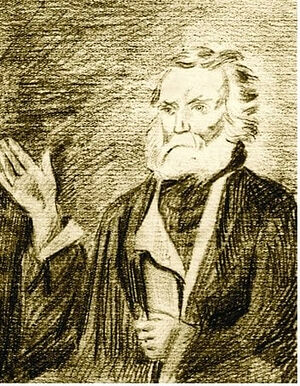 Lifetime portrait of Blessed John For his labors of prayer, fasting, enduring the cold and ridicule from people, and rejecting his own will, he acquired complete humility before God and was granted the gift of clairvoyance and miracle-working during his lifetime.
Lifetime portrait of Blessed John For his labors of prayer, fasting, enduring the cold and ridicule from people, and rejecting his own will, he acquired complete humility before God and was granted the gift of clairvoyance and miracle-working during his lifetime.
The fool for Christ was often seen at midnight praying before the Life-giving Cross of the Lord on the porch of the Holy Dormition Cathedral in the Tula Kremlin. Some people even saw him surrounded by a bright radiance and seemingly standing in the air while praying. Ever bearing the Crucified Christ in mind, he always kept his right hand raised.
The people of Tula preserve the memory of how Blessed John foretold the terrible fire of 1834. A few months before it occurred, the saint was walking along the streets of the city, waving his hands and blowing in all directions. Just before the fire, he went around to all the monastery cells and closed all the stovepipes. The monastery escaped the fire, while all the buildings around it were destroyed.
On Vozdvizhenskaya Street1 there stood the rich house of the landowner Esipov, and next to it—the poor hut of a widow and her children. Blessed John came with a bucket and splashed water all over the yard around the hut and immediately left. That same day, there was a fire in the Esipov house that destroyed an entire city block, except for the widow’s poor hut. Many then came to see this miraculously saved hut—a clear miracle of God’s mercy.
Archpriest V. N. Bogolyubov of the Sts. Peter and Paul Church heard from his mother that Blessed John foretold to her the death of her husband, who did then unexpectedly fall ill and died a few months later, although he had been completely healthy up to that point.
A certain shepherd who was watching over his flock saw Blessed John approach the Upa River and walk straight across on the surface of the water. The shepherd was stunned. The saint approached him and said: “My soul, tell no one what you have seen until my death. If you tell, you will be severely punished.” The shepherd spoke about this incident only when he came to bid farewell to the departed saint.
All his adult life, sixty whole years, Blessed John bore the greatest podvig, both externally:in the summer, the fool for Christ’s bare feet were disfigured by sharp rocks on the street;and in the winter, the skin on his legs was torn up by the cold, because even in severe frosts he always prayed very much, occasionally resting on the stone slabs of the church porch; and internally: a great ascesis of prayer, often hidden from people but always pleasing to God.
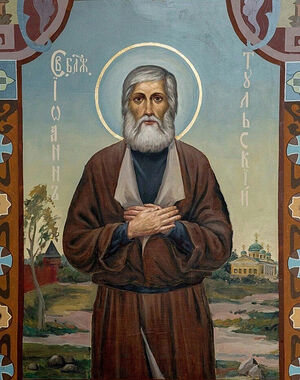 Icon of Blessed John in the upper church at the Holy Dormition Cathedral in Tula Blessed John foresaw the day of his repose, saying that “in two days they’ll be having a feast,” which came to pass just as he foretold. Blessed John the Wonderworker of Tula reposed on January 12/25, 1850. His funeral was served by Bishop Damascene (Rossov) of Tula and numerous clergy, with a large gathering of people.
Icon of Blessed John in the upper church at the Holy Dormition Cathedral in Tula Blessed John foresaw the day of his repose, saying that “in two days they’ll be having a feast,” which came to pass just as he foretold. Blessed John the Wonderworker of Tula reposed on January 12/25, 1850. His funeral was served by Bishop Damascene (Rossov) of Tula and numerous clergy, with a large gathering of people.
He was buried on January 15/28 under the porch at the St. Nicholas Chapel, at the place of his labors. Later, after the building was expanded, the holy fool’s grave ended up inside the church.
The church was destroyed in the 1930s and Blessed John’s remains were transferred to the All Saints Cemetery in the center of Tula.
In 1988, for the 1,000th anniversary of the Baptism of Rus’, the Bishops’ Council of the Russian Orthodox Church glorified John Stepanovich Koltenikov as a locally venerated saint.
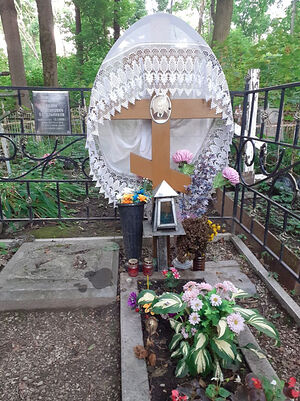 Grave of Blessed John at All Saints Cemetery The famous Tula elder, Schema-Archimandrite Christopher, greatly venerated Blessed John and would send his spiritual children to his grave even before his official glorification. One day, Blessed John appeared to Fr. Christopher in a dream and told him it was time to canonize him and uncover his relics. Struck by this phenomenon, Schema-Archimandrite Christopher went to see Vladyka Serapion. The Metropolitan treated the appearance reported by Fr. Christopher with complete seriousness and reverence. He didn’t make any decisions on his own but went to Moscow, to the Patriarch, and His Holiness gave the blessing to open the grave of Blessed John.
Grave of Blessed John at All Saints Cemetery The famous Tula elder, Schema-Archimandrite Christopher, greatly venerated Blessed John and would send his spiritual children to his grave even before his official glorification. One day, Blessed John appeared to Fr. Christopher in a dream and told him it was time to canonize him and uncover his relics. Struck by this phenomenon, Schema-Archimandrite Christopher went to see Vladyka Serapion. The Metropolitan treated the appearance reported by Fr. Christopher with complete seriousness and reverence. He didn’t make any decisions on his own but went to Moscow, to the Patriarch, and His Holiness gave the blessing to open the grave of Blessed John.
On August 3, 1990, the clerics of the All Saints Cathedral, headed by Metropolitan Serapion (Fadeyev) of Tula, gathered at the grave of Blessed John, and accompanied by the reading of the Psalter and the reverent singing of the clergy, the holy incorrupt relics of Blessed John of Tula were uncovered.
Until January 2007, his relics were to be found in the All Saints Cathedral. After the Holy Dormition Cathedral of the former Holy Dormition Convent was returned to the Russian Orthodox Church, the relics of Blessed John of Tula were installed on the first floor of the cathedral, to the left of the altar.

